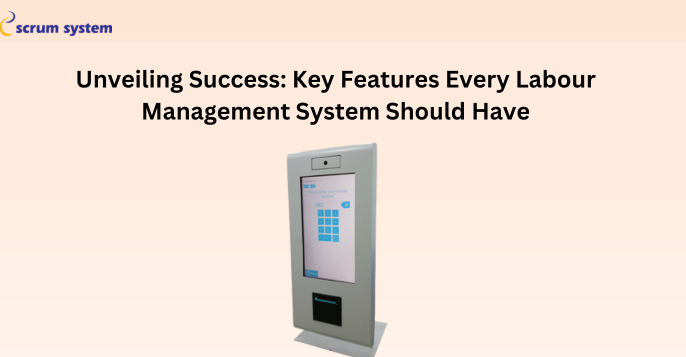In the dynamic landscape of modern business, effective workforce management is paramount for success. As companies strive to optimise their operations and enhance productivity, the role of Labour Management Systems (LMS) becomes increasingly crucial. These systems are designed to streamline processes, empower employees, and contribute to overall organisational efficiency. In this blog post, we will delve into the essential features that every Labour Management System should possess to ensure seamless workforce management.
Introduction
Labour Management System (LMS) has evolved from basic timekeeping tools to comprehensive solutions that integrate various aspects of workforce management. The key features discussed here are essential for maximising the potential benefits of an LMS and addressing the challenges associated with managing a diverse and dynamic workforce.
- Time and Attendance Tracking
At the core of any effective Contract Labour Management System is robust time and attendance tracking. This feature ensures accurate recording of employee work hours, breaks, and overtime. Modern LMS solutions often utilise biometric authentication, RFID cards, or mobile apps to provide secure and reliable tracking, reducing the likelihood of errors and improving payroll accuracy.
- Employee Scheduling and Shift Management
Efficient scheduling is critical for maintaining a balanced and productive workforce. An LMS should offer flexible scheduling capabilities, allowing managers to create, modify, and distribute work schedules seamlessly. Automated scheduling features help optimise staffing levels, minimise overtime costs, and ensure compliance with labour laws.
- Task and Project Management
To enhance productivity, LMS should go beyond time tracking and include task and project management features. This allows managers to assign tasks, set deadlines, and monitor project progress. Integrating these functions within the LMS ensures a centralised platform for comprehensive workforce oversight.
- Leave Management
Leave management is a vital aspect of employee well-being and organisational efficiency. An effective LMS should include features for requesting, approving, and tracking leaves. This ensures that staffing levels are maintained, and employee requests are managed transparently, fostering a positive work environment.
- Real-time Analytics and Reporting
In the fast-paced business environment, data-driven decision-making is crucial. LMS should provide real-time analytics and reporting features, offering insights into employee performance, attendance trends, and operational efficiency. Customizable dashboards empower managers to make informed decisions that align with organisational goals.
- Compliance and Regulatory Support
Adhering to labour laws and regulations is non-negotiable for businesses. An LMS should include features that facilitate compliance, such as automatic calculation of overtime, monitoring of work hour limits, and generation of reports for audits. Staying compliant not only avoids legal issues but also fosters a culture of fairness and transparency.
- Mobile Accessibility
In today’s mobile-centric world, the ability to access the LMS from anywhere is essential. Mobile accessibility enables employees to clock in/out, check schedules, and request leave on the go. Managers can also benefit from mobile access by staying informed about workforce activities in real-time, enhancing responsiveness to operational needs.
- Integration with HR and Payroll Systems
Seamless integration with HR and payroll systems is a key feature that streamlines administrative processes. An LMS should synchronise employee data, reducing redundancy and minimising the risk of errors in payroll processing. Integration ensures a cohesive flow of information across departments, enhancing overall organisational efficiency.
- Employee Self-Service Portals
Empowering employees with self-service portals is a feature that enhances engagement and reduces administrative overhead. Through these portals, employees can view their schedules, request time off, and access relevant information. This not only fosters transparency but also allows employees to take an active role in managing their work-related activities.
- Scalability and Flexibility
As businesses grow and evolve, their workforce management needs change. An effective LMS should be scalable and flexible to accommodate the changing requirements of the organisation. Whether it’s an increase in the number of employees, additional locations, or new functionalities, the LMS should adapt without compromising performance.
Conclusion
The success of any Contract Labour Management System software is paramount in the modern business landscape, where organisations continually strive for enhanced efficiency, compliance, and adaptability to dynamic needs. In this context, the Scrum Labour Management System stands out as a frontrunner due to its incorporation of key features that cater to the multifaceted requirements of businesses.
One of the distinctive strengths of the Scrum LMS lies in its comprehensive and user-friendly approach. The system is designed not just to meet the specific needs of an organisation but also to propel it towards greater efficiency. The user-friendly interface ensures that both management and employees can seamlessly navigate and utilise the system, fostering widespread adoption and ensuring that the LMS becomes an integral part of daily operations.
Moreover, the adaptability of the Scrum LMS is a crucial factor in its success. In today’s fast-paced and ever-changing business environment, having a system that can easily evolve to meet new challenges is essential. The Scrum LMS’s flexibility allows organisations to tailor the system to their unique workflows, ensuring that it remains relevant as business needs evolve over time.
In conclusion, the Scrum Labour Management System stands as a beacon of efficiency and adaptability in the realm of labour management. As businesses navigate the complexities of workforce optimization and compliance, the Scrum LMS emerges as a solution that not only meets these challenges but propels organisations towards greater heights of success in the dynamic and competitive business environment.
